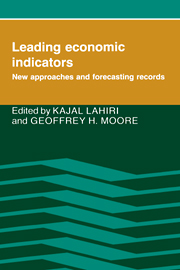Book contents
- Frontmatter
- Contents
- Preface
- List of contributors
- 1 Introduction
- PART I NEW CONCEPTS AND METHODS
- PART II FORECASTING RECORDS AND METHODS OF EVALUATION
- PART III NEW ECONOMIC INDICATORS
- 17 Commodity prices as a leading indicator of inflation
- 18 A leading indicator of inflation based on interest rates
- 19 Using composite leading indicators of consumption to forecast sales and to signal turning points in the stock market
- 20 Economic indicators for Australia's service sector
- 21 Purchasing management survey data: Their value as leading indicators
- 22 An agenda for inventories input to the leading composite index
- Index
20 - Economic indicators for Australia's service sector
Published online by Cambridge University Press: 05 June 2012
- Frontmatter
- Contents
- Preface
- List of contributors
- 1 Introduction
- PART I NEW CONCEPTS AND METHODS
- PART II FORECASTING RECORDS AND METHODS OF EVALUATION
- PART III NEW ECONOMIC INDICATORS
- 17 Commodity prices as a leading indicator of inflation
- 18 A leading indicator of inflation based on interest rates
- 19 Using composite leading indicators of consumption to forecast sales and to signal turning points in the stock market
- 20 Economic indicators for Australia's service sector
- 21 Purchasing management survey data: Their value as leading indicators
- 22 An agenda for inventories input to the leading composite index
- Index
Summary
The growing importance of the service industries justifies more attention being devoted to the development of indicators that reflect their part in economic fluctuations. In this chapter an attempt is made to apply to the service industries the indicator techniques that are well developed for analysis of the total economy. Leading, roughly coincident, and lagging indicators are identified for Australia's service industries. Composite indexes are constructed of five leading and four coincident indicators of the service industries. Both indexes are compared with the leading and coincident composite indexes that reflect the economic fluctuations in the total economy for Australia. The problems encountered in identifying service industry indicators are discussed.
One interesting finding is that the leading index for the service sector foreshadows equally as well as does our leading index for the total economy the pending changes in the pace and level of business activity. On the other hand, the coincident index for the service industries does not perform as consistently as does our coincident index for the total economy. However, both the leading and coincident indexes for the service sector are preliminary. Further work is being undertaken to improve their performance and also to identify more lagging indicators for the service sector. Nevertheless, it is believed that the results presented in this chapter help to clarify the role of the service industries in Australia's economic fluctuations.
- Type
- Chapter
- Information
- Leading Economic IndicatorsNew Approaches and Forecasting Records, pp. 373 - 402Publisher: Cambridge University PressPrint publication year: 1991



